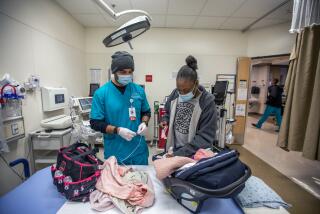Superbug study: ‘Universal’ MRSA control may make the most sense
Using antibacterial soap and ointments to treat all patients in an intensive care unit — not just those who test positive for methicillin-resistant Staphylococcus aureus, or MRSA — reduced presence of the antibiotic-resistant superbug by 37% and blood-borne infections in general by 44%, researchers said.
The finding suggests that the current practice of testing incoming patients for MRSA and isolating the ones who seem to have the bug on their bodies — which is recommended by the U.S. Centers of Disease Control and Prevention and mandated by nine states including California — might not be the best way to fight MRSA, which accounts for more healthcare-associated infections than any other bug.
ICU patients “are all high risk. Why not give them all the treatment?” said Dr. Susan Huang, medical director for infection prevention at the UC Irvine Medical Center and first author of a report detailing a study of 74,256 patients in 43 hospitals, published online Wednesday by the New England Journal of Medicine.
According to Huang, infectious disease specialists have debated for years whether the best way to protect vulnerable patients from MRSA is to screen for presence of the bacteria and isolate just those patients who test positive, or to forgo testing and treat everyone as if he or she might carry MRSA.
Hoping to test the two approaches head-to-head, she and colleagues from a number of institutions launched a study in 43 hospitals run by Hospital Corp. of America, which operates 162 hospitals in 20 states.
The team randomized hospitals into one of three groups. Over the course of 18 months, ICUs in the first group screened patients and isolated people who tested positive for MRSA. ICUs in the second group also screened and isolated patients, but additionally bathed MRSA-positive individuals daily using chlorhexidine, an antiseptic, and administered the antibiotic ointment mupirocin intranasally for five days. ICUs in the third group did away with screening and treated all ICU patients with the chlorhexidine and mupirocin interventions.
The third group was the only group that had a significant reduction in MRSA detections, Huang said, down 37%. Looking at numbers of bloodstream infections of any kind in the patients, she said, the third group also had the best result, decreasing infections a “remarkable” 44% (compared with a “not shabby” 23% in the second trial group).
“I hope this will move ICUs to make this standard practice,” she said, noting that Hospital Corp. had already made the change in its hospitals as the results of the study came to light. Huang also said that she thought the study would “raise a lot of questions” about laws requiring MRSA screening, like California’s.
“The implications of this study are highly important,” wrote Drs. Michael B. Edmond and Richard P. Wenzel of the division of infectious diseases at the Virginia Commonwealth University School of Medicine in Richmond in an editorial published with the study. They suggested that hospitals should discontinue screening and isolating patients for MRSA control and that laws mandating screening should be repealed. But they, and the study authors, also cautioned that hospitals would need to assess whether universal treatment would contribute to resistance to chlorhexidine and mupirocin.
In a statement, CDC Director Dr. Thomas Frieden said his agency, which was involved in the study, would review the research and “determine how the findings should inform CDC infection prevention recommendations.”
Huang said she was particularly excited that the work was “a pragmatic trial,” conducted almost entirely in community hospitals, as opposed to large research-oriented medical centers. Dr. Richard Platt of the Harvard Medical School and Dr. Jonathan Perlin of Hospital Corp. of America published a commentary through the Institute of Medicine talking more about the research’s place in the “learning health system.”
twitter.com/LATerynbrown







